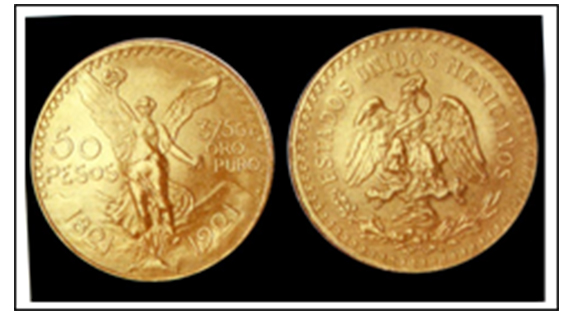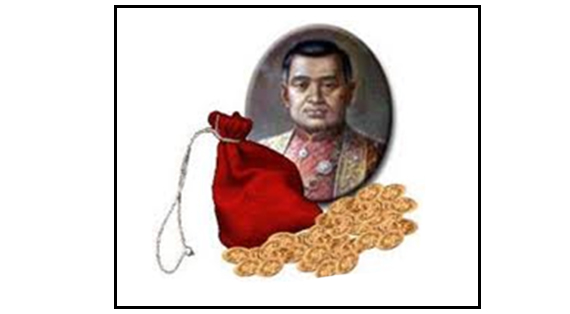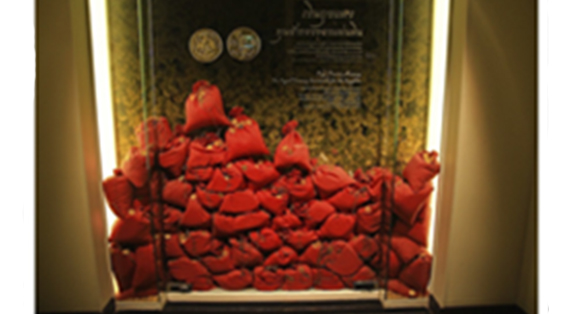Translated by Walter Eigner
The story of Red Purse Money is one part of Thai history that has been passed down but has never been proven or recorded clearly in historical records. It is said that King Rama III saved money that he earned from trading goods on samphao boats in red purses from which the name Red Purse Money was coined. He kept these purses on his bedside altar and every year the amount of money he had saved increased. This was considered his own private property and not money of the Treasury but it was set aside to use should Siam meet hard times.
Red Purse Money
In the Royal Chronicles of Rattanakosin during the reign of King Rama III, Chao Phraya Thiphakonwong spoke of important royal guidance that King Rama III said before he passed away:
"Our wars with Burma and Vietnam are over; they won’t be a threat anymore. Only the threats of western powers remain. We must be wary of them. We should study their innovations for our own benefit but not to the degree of obsession or worship. In these days I have been contemplating to detach myself from all the things that trouble my mind. Nevertheless, my major concern is that I have ordered the construction of several temples and there are some left incomplete. I am afraid there would not be anyone in charge of the restoration. Since there is the balance of 40,000 chang left in the Treasury, I hereby set aside 10,000 chang for this specific purpose. Inform whoever is going to be the regent that this total amount of money is meant for the restoration and construction of the incomplete temples.”
The Meaning of Red Purse Money
The Meaning of Red Purse Money
Red Purse Money was the royal savings of King Rama III which he received from trading goods on samphao boats, both with the state and with private boats since he was a prince. When he ascended to the throne in Buddhist Year 2367 (1824), King Rama III developed Siam’s prosperity and through his guidance, the nation’s foreign trade increased dramatically. He saved a great amount of money which he gained from his private trades and stored them in red purses on his bedside altar. For that reason it was referred to inside the royal court as Phra Khlang Khang Thi, meaning his adjacent depository, a name which continued into the reigns of King Rama IV and King Rama V.
Origins of the Red Purse Money
Origins of the Red Purse Money
Thailand has been engaged in trade with China since before the Sukhothai Kingdom and during the Ayutthaya Kingdom, Thailand began to trade with Portugal, Holland, Spain, Japan, Persia, Arab, France and many more nations. After the second fall of the Ayutthaya Kingdom during the Buddhist Year 2310 (1767), trade slowed down but it began to increase again during the Thonburi Kingdom through trade with China, Holland and Great Britain which continued into the Rattanakosin Kingdom and into the reign of King Rama III. Through trade, King Rama III had amassed a small fortune before he had even ascended to the throne through his skill in trading with goods on samphao boats not including his trades with state boats and the royal inheritance he received upon coronation. With this money he made merit through various acts of generosity and the remainder he saved in red purses from which the name was derived from. This money would later be of great benefit for future reigns in particular during the reign of King Rama V.
It should be noted that in the beliefs of the Chinese, red purses can eliminate risk and negativity. The fact that the purses are red is therefore auspicious and promotes good luck. It can be assumed through King Rama III’s use of red purses that he had been influenced through his trades with the Chinese. This money was reserved by King Rama III for use should Siam face troubled times and later helped Siam evade colonization. The relationship with the Chinese using red envelopes to give money to their children or during auspicious ceremonies is apparent as it is a sign of wealth, prosperity and good luck.
The Coins within the Red Purses
During the Kingdom of Rattanakosin, Siam had contact and trade with other nations and therefore Siam was likely to use foreign coins as a medium of exchange with foreign nations. During this period the coins which were accepted in Siam included coins from Meixco and Peru and Rupees from India alongside the Pod Duang of Siam. The coins within the red purses were likely to be foreign coins which were accepted in Thailandand were often indicated to be a Mexican 50 peso gold coin.

The Coins within the Red Purses
This was a round, flat coin which had the image of an eagle on one side with its wings spread out and a snake held within its beak, a national symbol of Mexico. This coin was therefore referred to within Thailand as Rein Nok, meaning Bird Coin. These coins had the value of 48 pieces equaling one chang (80 baht). The records during the incident of Rattanakosin year 112 (1893) state that King Rama V said that they must pay France the sum of 1,605,235 baht and two att by the 22nd of August that year, equaling about 20,000 chang or 960,000 bird coins. The money referred to in the historical records of King Rama III therefore could not refer to the red purse money of King Rama III as it equaled 40,000 chang with instruction to spend 10,000 chang. That would leave 30,000 chang which should have been enough to pay France yet even with the red purse money and the money left at the Treasury; Siam had to resort to donations to be able to pay the money demanded by France.
Despite the presumptions that the coins in the red purses were Mexican bird coins, the Mexican bird coins bore the date range 1821 – 1921 indicating they were commemorative coins commemorating a hundred years of Mexican independence. These coins were struck from 1921 and therefore could not be found during the reign of King Rama III which was from Buddhist year 2367 to Buddhist year 2394 (1824-1851). It is more likely that the coins in the red purses were Mexican silver coins from the era of King Rama III.
The Importance of the Red Purse Money
The Importance of the Red Purse Money
The benefits of the Red Purse Money were seen after the incident during the Rattanakosin year 112 (1893) in which the money helped Siam evade becoming a colony of France. This is an interesting story which teaches an important lesson as told in the royal papers of his majesty, issue 13 by Somdet Phra Chao Borommawong Thoe Phra Ong Chao Krom Phraya Damrong Rachanuphap which states:
It was once said, "In the past, the king had a chest of his savings next to his bed for whichever king needed it. There was no need to let anybody else know but it was possibly a tradition from the Ayutthaya Kingdom or it might have come about during the Rattanakosin Kingdom. I’m not certain. It has been called ngern khang thi, or money adjacent. It was possibly passed down in a similar way to the money which follows royalty, that being ngern thai thi nang or back seat money and was perhaps taken from the treasury itself. He must have saved this money so that it would increase in value during his reign and so that he could use it for charity. This money was called red purse money, reserved for use when Siam suffered. It was probably kept in a safe and then moved to its own room so it was often called khlang khang tii, meaning adjacent depository. This name therefore originated during the reign of King Rama III but it appears as though the name originated from the palace during the reign of King Rama IV as this name would later be used as the name of the Treasury Department during the reign of King Rama V.”
Because of the Franco-Siamese war during the reign of King Rama V, France gave the government of Siam an ultimatum. France demanded Siam pay reparations of 3 million francs within 48 hours otherwise the French navy would blockade Siam and order the French ambassador to leave Siam and Siam would become a colony of France. It was written The late king in the western world, the Royal History during the reign of King Rama V "The problem of Thailand was finding such a great amount of money in time. The Minister of the Treasury says that the money in the treasury was not enough for what the French demanded but one tells of capital from the reign of King Rama III which was saved in red purses.” The red purse money was therefore brought to pay for the demands of the French.
In addition to this Mom Chao Phunphitsamai Ditsakun stated in regards to the Franco-Siamese war, "France did not permit Siam to pay in banknotes, but demanded that they pay the full amount in precious metal coins. They needed to use money from the red purses that King Rama III had set aside for use during troubled times. It was told that the public servants at the palace took their money in bags and brought it to the harbor to load onto boats all day and all night.”
The money in the red bags was saved by King Rama III from his trades with foreigners on samphao boats to be reserved for resolving national problems. It was eventually used to preserve the independence of the nation by preventing it from becoming a colony of France by using the money to pay war reparations but it wasn’t sufficient. All the royalty and public servants therefore had to help out with the payment by offering their money, gold, necklaces, diamonds, jasper and gems to trade for coins all day and all night as they only had 48 hours to pay. It is said that due to the weight of the trucks moving the bounty which weighed 23 tons, the roads they drove on were damaged. The story of red purse money is probably a true story about the history of the Rattanakosin Kingdom that Thai people should remember.
Abstract
The story of red purse money isn’t the only share of royal property used to help the problems faced by Siam as a result of the Franco-Siamese war in Rattanakosin year 112 (1893) but it provides insight into Siam’s contact and relationship with the west during the reign of King Rama III which is shown through the influence the west had on the coins used during the period. It also reflects the long-sighted visions of King Rama III in foreseeing the dangers presented by western powers during that era and the incidents that may occur in the future. In his royal speech he stated that Thai people should adopt and gain experience in modern technology. Red purse money therefore should remind Thai people to preserve life and not be careless, know the importance of saving for hard times as taught by King Rama III. He saved money to assist in solving problems that may occur in the future. This story therefore serves as a reminder to Thai people of the Royal Grace that the King has for all Thais and for nation of
Thailand.
Translated from
เงินถุงแดง by SomSak Ritpakdee
<http://emuseum.treasury.go.th/article/376-thungdaeng.html>





